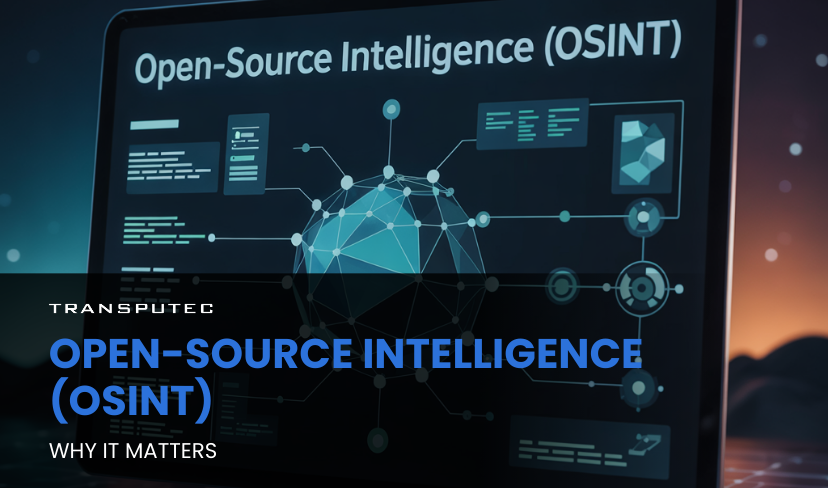Written by KRITIKA SINHA | MARKETING
Every business today, regardless of size or industry, generates a vast amount of data—financial records, employee details, customer interactions, and supply chain information. But did you know that cybercriminals, competitors, and even malicious insiders can access critical insights about your company using publicly available data?
This is where Open-Source Intelligence (OSINT) becomes a game-changer. OSINT involves collecting and analysing publicly accessible information to uncover hidden threats, monitor risks, and gain strategic insights. From safeguarding against cyberattacks to competitive intelligence, businesses can no longer afford to ignore OSINT.
In this blog, we’ll explore what Open-Source Intelligence (OSINT) is, how it works, its benefits for businesses, and why it is essential for your cybersecurity strategy. We’ll also discuss how Transputec can help businesses leverage OSINT to protect their assets and gain a competitive edge.
What Is Open-Source Intelligence (OSINT)?
Open-Source Intelligence (OSINT) refers to the process of collecting and analysing publicly available data from various sources to gain valuable insights. These sources include:
- Social media platforms
- News websites and blogs
- Government databases
- Corporate filings
- Dark web forums
- Geospatial data and satellite imagery
OSINT is widely used in cybersecurity, fraud detection, corporate security, and competitive intelligence. According to a 2023 report by Cybersecurity Ventures, more than 90% of all security incidents involve OSINT-exposed data, making it a crucial aspect of modern business security.
How Does Open-Source Intelligence (OSINT) Work?
The OSINT process involves several key steps:
1. Data Collection
Publicly available data is gathered from websites, social media, financial records, and government sources. OSINT tools such as Maltego, Shodan, and Google Dorks help automate this process.
2. Data Processing & Analysis
Collected data is analysed using advanced algorithms, artificial intelligence (AI), and human intelligence to extract meaningful insights.
3. Threat Detection & Intelligence Reporting
The processed data is used to identify cybersecurity vulnerabilities, detect fraud, monitor brand reputation, and gain competitive insights.
4. Actionable Decision-Making
Businesses use OSINT findings to strengthen security measures, prevent attacks, and make strategic decisions.
Ready to Take Your Business's Security to the Next Level?
Connect with us today for our free consultation!
Why Should Your Business Care About OSINT?
1. Cybersecurity Risk Management
OSINT helps businesses identify security vulnerabilities before hackers exploit them. Cybercriminals often use OSINT techniques to gather information about companies before launching cyberattacks. By leveraging OSINT proactively, businesses can detect weak points and secure their digital infrastructure.
2. Fraud Detection and Prevention
Financial fraud and identity theft cases are rising. OSINT enables companies to track suspicious transactions, identify fraudulent activities, and monitor deep web discussions related to stolen credentials or payment data.
3. Brand Reputation and Crisis Management
With OSINT, businesses can monitor social media platforms and online forums for negative mentions, fake news, or brand impersonation. This allows companies to respond quickly to reputation threats and protect their brand image.
4. Competitive Intelligence
OSINT helps businesses analyse market trends, track competitors’ activities, and uncover emerging opportunities. By gathering intelligence from publicly available sources, companies can make informed business decisions.
5. Employee and Insider Threat Monitoring
A report by IBM found that 60% of data breaches involve insider threats, either through negligence or malicious intent. OSINT tools can help businesses detect suspicious activities among employees or partners that might pose security risks.
Key OSINT Tools and Techniques Businesses Should Know
To fully leverage Open-Source Intelligence (OSINT), businesses need to understand the tools and techniques that enable effective data collection and analysis. These tools help organisations uncover cybersecurity threats, monitor brand reputation, track competitors, and prevent fraud. Below, we explore some of the most powerful OSINT tools and techniques businesses should know.
1. Google Dorks: The Hidden Power of Advanced Search
Google Dorks is a technique that utilises advanced search queries to find publicly available but often overlooked data on websites. Cybercriminals frequently use Google Dorks to discover exposed login credentials, unsecured databases, and hidden company files.
How Businesses Can Use It:
- Identify misconfigured web pages that expose sensitive company information.
- Check for publicly available login pages to assess potential vulnerabilities.
- Find internal documents or confidential data accidentally exposed online.
2. Shodan: The Search Engine for Internet-Connected Devices
Shodan is a powerful OSINT tool that allows users to search for internet-connected devices, such as servers, webcams, industrial control systems, and IoT devices. Unlike Google, which indexes websites, Shodan indexes exposed devices worldwide.
How Businesses Can Use It:
- Identify unsecured company servers and exposed databases.
- Detect Internet of Things (IoT) devices that may be vulnerable to attacks.
- Monitor corporate networks for unauthorised access points.
3. Maltego: Visualising Digital Footprints
Maltego is an OSINT tool that maps relationships between people, organisations, websites, social media accounts, and networks. It provides a visual representation of digital footprints, making it an essential tool for security investigations.
How Businesses Can Use It:
- Conduct deep investigations into cybersecurity threats and insider risks.
- Track digital connections between hackers, fraudsters, and cybercriminals.
- Analyse social media profiles to uncover brand impersonation or phishing attacks.
4. Have I Been Pwned: Protecting Against Data Breaches
Have I Been Pwned (HIBP) is a free OSINT tool that checks if an email address, domain, or password has been compromised in a data breach. With cyberattacks increasing, businesses must monitor employee credentials to prevent unauthorised access.
How Businesses Can Use It:
- Check if corporate emails or employee credentials have been leaked.
- Monitor company domains for security breaches.
- Identify exposed passwords that hackers could use in attacks.
5. Social Media Intelligence (SOCMINT): Monitoring Online Activity
Social Media Intelligence (SOCMINT) involves analysing publicly available social media content to gather intelligence on potential threats, customer sentiment, or competitor activity.
How Businesses Can Use It:
- Detect fraudulent brand impersonation on social media.
- Monitor negative customer feedback and emerging reputation risks.
- Uncover employee misconduct or insider threats.
6. The Wayback Machine: Recovering Deleted Content
The Wayback Machine (by the Internet Archive) is an OSINT tool that stores historical versions of websites. Businesses can use it to retrieve deleted information, track changes in competitors’ websites, and uncover past security vulnerabilities.
How Businesses Can Use It:
- Recover deleted content that may still hold valuable information.
- Analyse historical changes in competitor websites or pricing strategies.
- Identify previously exposed security flaws that might still exist.
7. WHOIS Lookup: Investigating Domain Ownership
A WHOIS lookup provides information on who owns a particular domain name, including registration details, contact information, and hosting providers. This technique is useful for identifying fraudulent websites, tracking cybercriminals, and protecting against phishing attacks.
How Businesses Can Use It:
- Verify whether a suspicious website is legitimate.
- Detect phishing domains impersonating a company.
- Track domain registrations by competitors or threat actors.
How Transputec Helps Businesses with Open-Source Intelligence (OSINT)
At Transputec, we specialise in OSINT-powered security solutions to help businesses protect their data, monitor risks, and gain valuable intelligence. Our OSINT services include:
1. Threat Intelligence & Risk Assessment
Identifying potential cyber threats before they impact your business.
2. Dark Web Monitoring
Detecting stolen credentials and sensitive business data being sold online.
3. Corporate Security & Brand Protection
Monitoring unauthorised use of your brand and intellectual property.
4. Fraud Prevention & Investigation
Uncovering fraudulent activities through deep data analysis.
5. Competitive & Market Intelligence
Providing actionable insights into competitors, market trends, and industry developments.
By partnering with Transputec, your business gains access to cutting-edge OSINT tools, expert analysts, and real-time intelligence reports that empower you to stay ahead of potential threats.
Conclusion
The growing threats in the digital world make Open-Source Intelligence (OSINT) an indispensable tool for businesses. Whether it’s preventing cyberattacks, tracking fraud, monitoring brand reputation, or gaining competitive intelligence, OSINT provides actionable insights that enhance security and strategic decision-making. At Transputec, we provide comprehensive OSINT services tailored to your business needs. Our experts analyse vast amounts of public data to help you detect risks, mitigate threats, and protect your business assets.
Don’t wait until your business becomes a target. Contact Transputec today to speak with our OSINT experts and get started with a customised security solution!

Secure Your Business!
Ready to explore how we can enhance your security posture? Contact us today to speak with one of our experts.
FAQs
1. What industries benefit most from Open-Source Intelligence (OSINT)?
OSINT is valuable for industries such as finance, healthcare, cybersecurity, law enforcement, retail, and government agencies. Any business dealing with sensitive data, fraud prevention, or market intelligence can benefit from OSINT.
2. Is OSINT legal to use for business intelligence?
Yes, OSINT is legal as it involves collecting publicly available information. However, businesses must comply with data privacy laws such as GDPR, CCPA, and industry regulations. Transputec ensures ethical OSINT practices aligned with compliance standards.
3. How does Transputec’s OSINT service enhance cybersecurity?
Transputec’s OSINT services provide real-time threat intelligence, dark web monitoring, and vulnerability detection. We help businesses identify risks before they escalate into cyber incidents, reducing the likelihood of breaches and fraud.
4. Can OSINT help prevent insider threats?
Yes. OSINT enables businesses to monitor employee activities, detect suspicious behaviour, and prevent data leaks. Transputec offers tailored OSINT solutions to identify potential insider threats and ensure corporate security.
5. How can businesses integrate OSINT into their security strategy?
Businesses can integrate OSINT by leveraging advanced analytics, automated tools, and expert guidance. Transputec provides custom OSINT strategies, training, and intelligence reports to help businesses stay ahead of emerging threats.







